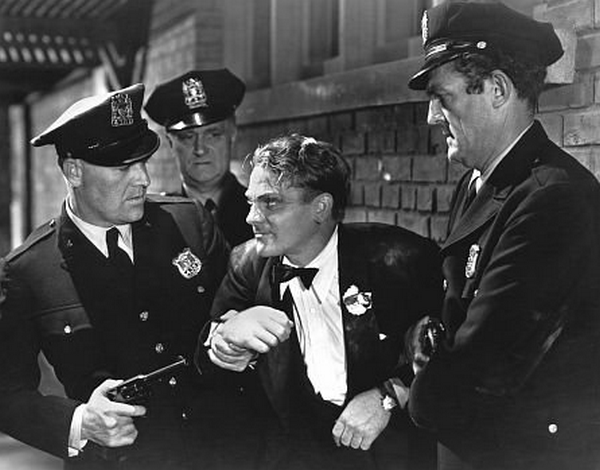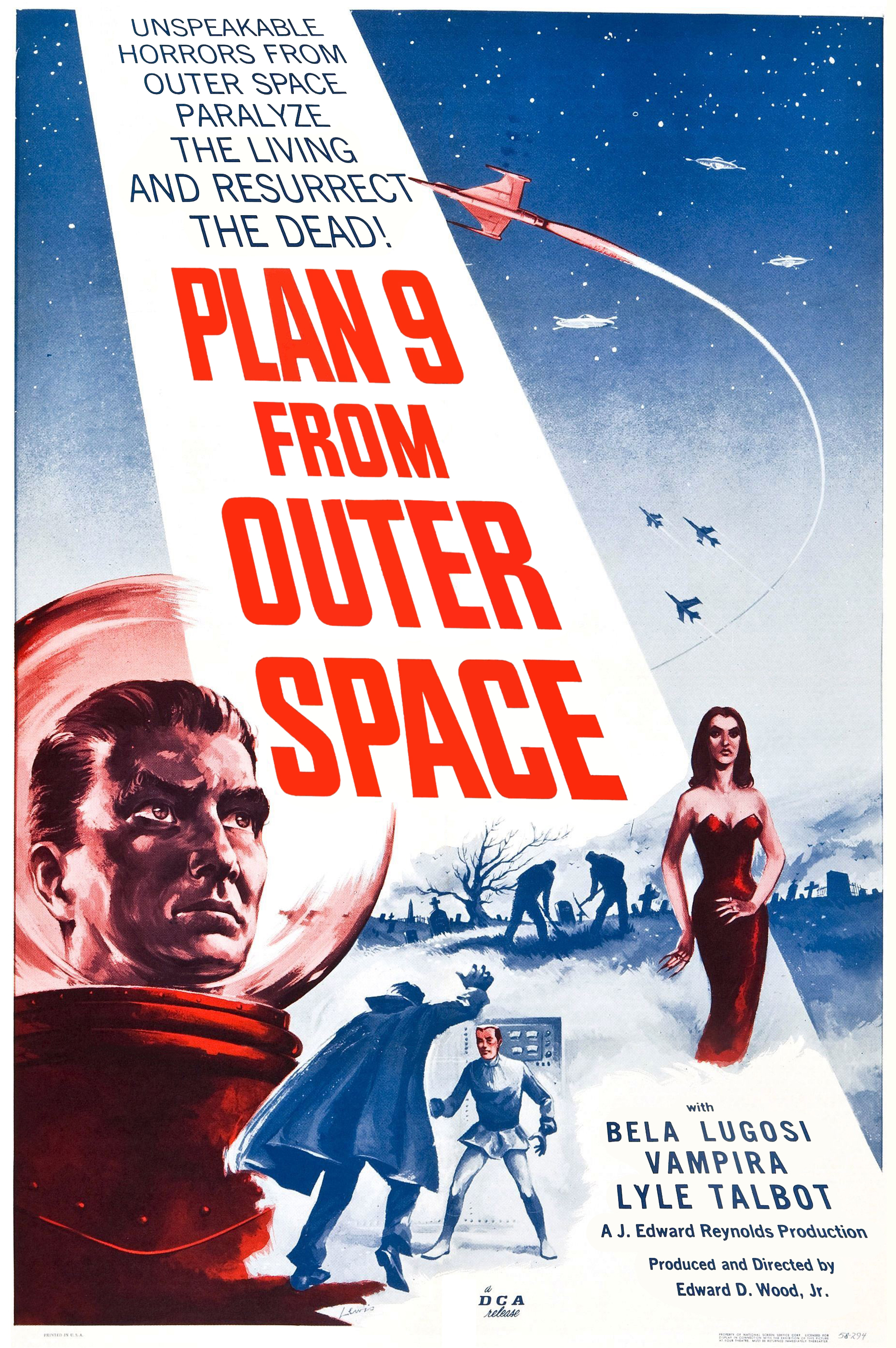|
Gangsters Versus Cowboys
''Gangsters Versus Cowboys'' (Spanish:''Gangsters contra charros'') is a 1948 Mexican gangster film written, directed by, and starring Juan Orol, and featuring Rosa Carmina and José Pulído. It was made as a sequel to Orol's ''Gangster's Kingdom''. However, it has become a cult film due to its low-budget production values and idiosyncratic style. Plot Gangster Johnny Carmenta (Juan Orol), faces Pancho Dominguez ''El Charro del Arrabal'' (Jose Pulido), who has imposed his law in the town. The ''Rumbera'' Rosa (Rosa Carmina) seduces both men firing their rivalry. Cast * Juan Orol as Johnny Carmenta * Rosa Carmina as Rosa * José Pulído as Pancho Domínguez ''El Charro del Arrabal'' * Roberto Cañedo as Julio Legacy The film has sometimes been compared with the work of American filmmaker Ed Wood, known as "the worst director of all time". However, in contrast to Wood's films, Gangsters Versus Cowboys was successful at the box office. Orol's films were popular, despite their techni ... [...More Info...] [...Related Items...] OR: [Wikipedia] [Google] [Baidu] |
Juan Orol
Juan Rogelio García García, better known as Juan Orol (August 4, 1897 in Lalín, Pontevedra, Spain – May 26, 1988 in Mexico City, Mexico) was a Mexican-Spanish actor, producer, screenwriter and film director. He was known as ''The King of the Mexican Film noir''. He was also known as ''The Involuntary Surrealist''. He was a pioneer of the Mexican cinema's first talkies and one of the main promoters of the Rumberas film in the ''Golden Age of Mexican cinema''. His films have been described as cult films. Biography Early life Juan Rogelio García García was born on August 4, 1897 in the parish of Santiso, in the town of Lalin in Pontevedra, Spain. His father was a commander of the Spanish armed forces. His mother, a woman of peasant origin, was a single mother. Later, she married a man who didn't want to take care of another man's son, so she sent Orol to Cuba to live with a friend. In Cuba, Orol lived in the low neighborhoods, known in Cuba as "solares". There, he had ... [...More Info...] [...Related Items...] OR: [Wikipedia] [Google] [Baidu] |
Rosa Carmina
Rosa Carmina Riverón Jiménez (born November 19, 1929) is a Cuban-Mexican actress and dancer. She was discovered in Cuba by the Spanish filmmaker Juan Orol, and made her debut in Mexican cinema in Orol's film ''A Woman from the East'' in 1946. She quickly achieved great popularity in the Mexico thanks to her talent, demeanor, and unconventional stature (being very tall for an actresses of the time). For several years, she was part of the film crew of Juan Orol in his best gangster films. Among these are the classic ''Gangsters Versus Cowboys'' (1948), considered one of the best Mexican films and considered a cult film in several film clubs around the world. Additionally, Rosa Carmina was one of the principal stars of the Rumberas film of the Golden Age of Mexican cinema in the 1940s and 1950s. Among her principal Rumberas films are ''Tania, the Beautiful Wild Girl'' (1947), '' Wild Love'' (1949), ''In the Flesh'' (1951), '' Voyager'' (1952) and '' Sandra, the Woman of Fire'' (1954 ... [...More Info...] [...Related Items...] OR: [Wikipedia] [Google] [Baidu] |
México
Mexico (Spanish: México), officially the United Mexican States, is a country in the southern portion of North America. It is bordered to the north by the United States; to the south and west by the Pacific Ocean; to the southeast by Guatemala, Belize, and the Caribbean Sea; and to the east by the Gulf of Mexico. Mexico covers ,Mexico ''''. . making it the world's 13th-largest country by are ... [...More Info...] [...Related Items...] OR: [Wikipedia] [Google] [Baidu] |
Gangster Film
A gangster film or gangster movie is a film belonging to a genre that focuses on gangs and organized crime. It is a subgenre of crime film, that may involve large criminal organizations, or small gangs formed to perform a certain illegal act. The genre is differentiated from Westerns and the gangs of that genre. Overview The American Film Institute defines the genre as "centered on organized crime or maverick criminals in a twentieth century setting". The institute named it one of the 10 "classic genres" in its 10 Top 10 list, released in 2008. The list recognizes 3 films from 1931 & 1932 ('' Scarface'', ''The Public Enemy'' & '' Little Caesar''). Only 1 film made the list from 1933 to 1966, (''White Heat'' (1949)). This was at least partly due to the limitations on the genre imposed by the Hays Code, which was finally abandoned in favor of the Motion Picture Association of America film rating system in 1968. The genre was revitalized in the New Hollywood movement that followed. ... [...More Info...] [...Related Items...] OR: [Wikipedia] [Google] [Baidu] |
Gangster's Kingdom
''Gangster's Kingdom'' (Spanish:''El reino de los gángsters'') is a 1948 Mexican crime film written and directed by Juan Orol who also starred in the film. Like Orol's other films it was an attempt to copy the style of Hollywood films of the era.Balderston, Gonzalez & Lopez p.1080 Cast * Víctor Alcocer * Jorge Arriaga * Manuel Arvide * Rosa Carmina * Roberto Cañedo * Roberto Corell * Rafael María de Labra * Francisco Jambrina * Cecilia Leger as Mamá * Kiko Mendive * Juan Orol * José Pardavé * Rafael Plaza Balboa * Lilia Prado * Juanita Riverón * Joaquín Roche * Ramón Vallarino * Armando Velasco * Eduardo Vivas Eduardo is the Spanish and Portuguese form of the male given name Edward. Another version is Duarte. It may refer to: Association football * Eduardo Bonvallet, Chilean football player and sports commentator * Eduardo Carvalho, Portuguese football ... * Enrique Zambrano References Bibliography * Daniel Balderston, Mike Gonzalez & Ana M. Lopez. ... [...More Info...] [...Related Items...] OR: [Wikipedia] [Google] [Baidu] |
Cult Film
A cult film or cult movie, also commonly referred to as a cult classic, is a film that has acquired a cult following. Cult films are known for their dedicated, passionate fanbase which forms an elaborate subculture, members of which engage in repeated viewings, dialogue-quoting, and audience participation. Inclusive definitions allow for major studio productions, especially box-office bombs, while exclusive definitions focus more on obscure, transgressive films shunned by the mainstream. The difficulty in defining the term and subjectivity of what qualifies as a cult film mirror classificatory disputes about art. The term ''cult film'' itself was first used in the 1970s to describe the culture that surrounded underground films and midnight movies, though ''cult'' was in common use in film analysis for decades prior to that. Cult films trace their origin back to controversial and suppressed films kept alive by dedicated fans. In some cases, reclaimed or rediscovered films ... [...More Info...] [...Related Items...] OR: [Wikipedia] [Google] [Baidu] |
Idiosyncrasy
An idiosyncrasy is an unusual feature of a person (though there are also other uses, see below). It can also mean an odd habit. The term is often used to express eccentricity or peculiarity. A synonym may be "quirk". Etymology The term "idiosyncrasy" originates from Greek ', "a peculiar temperament, habit of body" (from ', "one's own", ', "with" and ', "blend of the four humors" (temperament)) or literally "particular mingling". Linguistics The term can also be applied to symbols or words. ''Idiosyncratic symbols'' mean one thing for a particular person, as a blade could mean war, but to someone else, it could symbolize a surgery. Idiosyncratic property In phonology, an ''idiosyncratic property'' contrasts with a ''systematic regularity''. While systematic regularities in the sound system of a language are useful for identifying phonological rules during analysis of the forms morphemes can take, idiosyncratic properties are those whose occurrence is not determined by those rul ... [...More Info...] [...Related Items...] OR: [Wikipedia] [Google] [Baidu] |
Ed Wood
Edward Davis Wood Jr. (October 10, 1924 – December 10, 1978) was an American filmmaker, actor, and pulp novel author. In the 1950s, Wood directed several low-budget science fiction, crime and horror films that later became cult classics, notably ''Glen or Glenda'' (1953), '' Jail Bait'' (1954), '' Bride of the Monster'' (1955), '' Plan 9 from Outer Space'' (1957)Rudolph Grey, Nightmare of Ecstasy: The Life and Art of Edward D. Wood, Jr. (1992). pg. 197. ISBN 978-0-922915-24-8. and '' Night of the Ghouls'' (1959). In the 1960s and 1970s, he moved towards sexploitation and pornographic films such as '' The Sinister Urge'' (1960), '' Orgy of the Dead'' (1965) and '' Necromania'' (1971), and wrote over 80 lurid pulp crime and sex novels. Notable for their campy aesthetics, technical errors, unsophisticated special effects, use of poorly-matched stock footage, eccentric casts, idiosyncratic stories and non sequitur dialogue, Wood's films remained largely obscure unt ... [...More Info...] [...Related Items...] OR: [Wikipedia] [Google] [Baidu] |
Mexican Cinema
Mexican cinema dates to the late nineteenth century during the rule of President Porfirio Díaz. Seeing a demonstration of short films in 1896, Díaz immediately saw the importance of documenting his presidency in order to present an ideal image of it. With the outbreak of the Mexican Revolution in 1910, Mexican and foreign makers of silent films seized the opportunity to document its leaders and events. From 1915 onward, Mexican cinema focused on narrative film. During the Golden Age of Mexican cinema from 1936 to 1956, Mexico all but dominated the Latin American film industry. The Guadalajara International Film Festival is the most prestigious Latin American film festival and is held annually In Guadalajara, Mexico. Mexico has twice won the highest honor at the Cannes Film Festival, having won the ''Grand Prix du Festival International du Film'' for ''María Candelaria'' in 1946 and the Palme d'Or in 1961 for ''Viridiana'', more than any other Latin American nation. In 2 ... [...More Info...] [...Related Items...] OR: [Wikipedia] [Google] [Baidu] |
1948 Crime Films
Events January * January 1 ** The General Agreement on Tariffs and Trade (GATT) is inaugurated. ** The Constitution of New Jersey (later subject to amendment) goes into effect. ** The railways of Britain are nationalized, to form British Railways. * January 4 – Burma gains its independence from the United Kingdom, becoming an independent republic, named the ''Union of Burma'', with Sao Shwe Thaik as its first President, and U Nu its first Prime Minister. * January 5 ** Warner Brothers shows the first color newsreel (''Tournament of Roses Parade'' and the '' Rose Bowl Game''). ** The first Kinsey Report, ''Sexual Behavior in the Human Male'', is published in the United States. * January 7 – Mantell UFO incident: Kentucky Air National Guard pilot Thomas Mantell crashes while in pursuit of an unidentified flying object. * January 12 – Mahatma Gandhi begins his fast-unto-death in Delhi, to stop communal violence during the Partition of India. * January 1 ... [...More Info...] [...Related Items...] OR: [Wikipedia] [Google] [Baidu] |
1948 Films
The year 1948 in film involved some significant events. Top-grossing films (U.S.) The top ten 1948 released films by box office gross in North America are as follows: Events * May 3 – The Supreme Court of the United States decide in ''United States v. Paramount Pictures, Inc.'' holding that the practice of block booking and ownership of theater chains by film studios constituted anti-competitive and monopolistic trade practices. * Laurence Olivier's ''Hamlet'' becomes the first British film to win the American Academy Award for Best Picture. Awards Top ten money making stars Notable films released in 1948 United States unless stated # *''3 Godfathers'', starring John Wayne A *''Abbott and Costello Meet Frankenstein'', starring Bud Abbott and Lou Costello *''Act of Violence'', starring Van Heflin, Robert Ryan, Janet Leigh *''Adventures of Don Juan'', starring Errol Flynn *''Albuquerque'', starring Randolph Scott and Barbara Britton *''The Amazing Mr. X'', starring T ... [...More Info...] [...Related Items...] OR: [Wikipedia] [Google] [Baidu] |
Mexican Black-and-white Films
Mexican may refer to: Mexico and its culture *Being related to, from, or connected to the country of Mexico, in North America ** People *** Mexicans, inhabitants of the country Mexico and their descendants *** Mexica, ancient indigenous people of the Valley of Mexico ** Being related to the State of Mexico, one of the 32 federal entities of Mexico ** Culture of Mexico *** Mexican cuisine *** historical synonym of Nahuatl, language of the Nahua people (including the Mexica) Arts and entertainment * "The Mexican" (short story), by Jack London * "The Mexican" (song), by the band Babe Ruth * Regional Mexican, a Latin music radio format Films * ''The Mexican'' (1918 film), a German silent film * ''The Mexican'' (1955 film), a Soviet film by Vladimir Kaplunovsky based on the Jack London story, starring Georgy Vitsin * ''The Mexican'', a 2001 American comedy film directed by Gore Verbinski, starring Brad Pitt and Julia Roberts Other uses * USS ''Mexican'' (ID-1655), United State ... [...More Info...] [...Related Items...] OR: [Wikipedia] [Google] [Baidu] |



